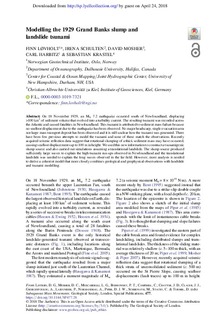| dc.contributor.author | Løvholt, Finn | |
| dc.contributor.author | Schulten, Irena | |
| dc.contributor.author | Mosher, David | |
| dc.contributor.author | Harbitz, Carl Bonnevie | |
| dc.contributor.author | Krastel, Sebastian | |
| dc.date.accessioned | 2018-05-28T08:11:36Z | |
| dc.date.available | 2018-05-28T08:11:36Z | |
| dc.date.created | 2018-04-27T09:07:02Z | |
| dc.date.issued | 2018 | |
| dc.identifier.isbn | 9781786203823 | |
| dc.identifier.uri | http://hdl.handle.net/11250/2499370 | |
| dc.description.abstract | On 18 November 1929, an Mw 7.2 earthquake occurred south of Newfoundland, displacing >100 km3 of sediment volume that evolved into a turbidity current. The resulting tsunami was recorded across the Atlantic and caused fatalities in Newfoundland. This tsunami is attributed to sediment mass failure because no seafloor displacement due to the earthquake has been observed. No major headscarp, single evacuation area nor large mass transport deposit has been observed and it is still unclear how the tsunami was generated. There have been few previous attempts to model the tsunami and none of these match the observations. Recently acquired seismic reflection data suggest that rotational slumping of a thick sediment mass may have occurred, causing seafloor displacements up to 100 m in height. We used this new information to construct a tsunamigenic slump source and also carried out simulations assuming a translational landslide. The slump source produced sufficiently large waves to explain the high tsunami run-ups observed in Newfoundland and the translational landslide was needed to explain the long waves observed in the far field. However, more analysis is needed to derive a coherent model that more closely combines geological and geophysical observations with landslide and tsunami modelling. | |
| dc.language.iso | eng | |
| dc.relation.ispartof | SP477 Subaqueous Mass Movements and Their Consequences: Assessing Geohazards, Environmental Implications and Economic Significance of Subaqueous Landslides | |
| dc.title | Modelling the 1929 Grand Banks slump and landslide tsunami | |
| dc.type | Chapter | |
| dc.description.version | publishedVersion | |
| dc.identifier.cristin | 1582032 | |
| dc.relation.project | Norges forskningsråd: 231252 | |
| cristin.unitcode | 7452,4,2,0 | |
| cristin.unitcode | 7452,3,3,0 | |
| cristin.unitname | Computational Geomechanics (CGM) | |
| cristin.unitname | Risiko, Skredgeoteknikk og Klimatilpasning | |
| cristin.ispublished | true | |
| cristin.fulltext | original | |
| cristin.qualitycode | 1 | |
